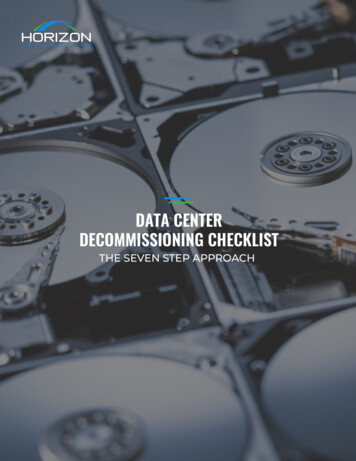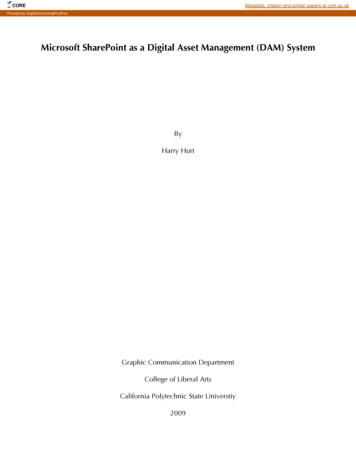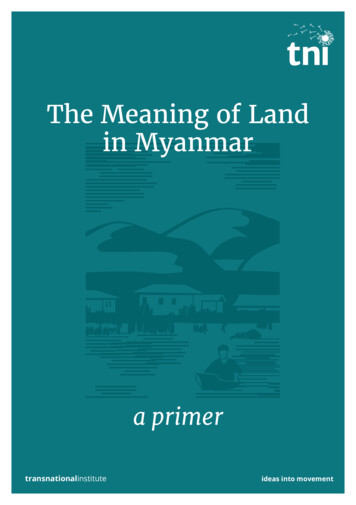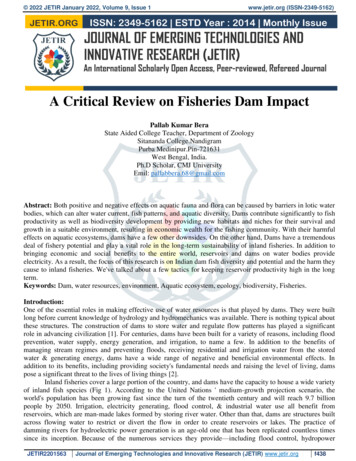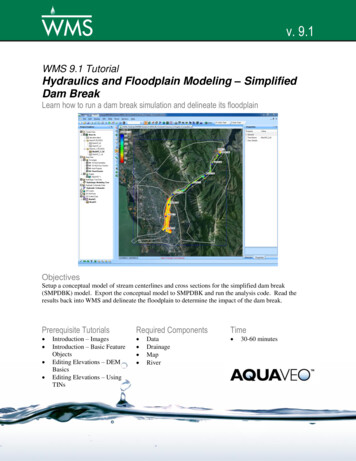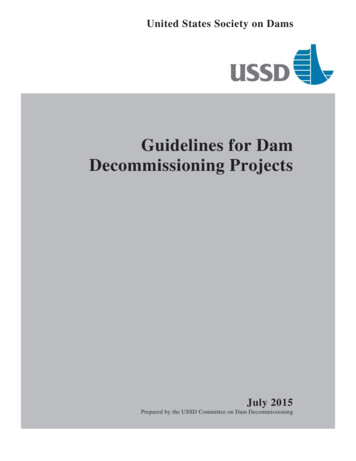
Transcription
United States Society on DamsGuidelines for DamDecommissioning ProjectsJuly 2015Prepared by the USSD Committee on Dam Decommissioning
U.S. Society on DamsVisionA world class organization dedicated to advancing the role of dam and leveesystems and building the community of practice.MissionUSSD, as the United States member of the International Commission on LargeDams, is dedicated to:ADVOCATE: Champion the role of dam and levee systems in society.EDUCATE: Be the premier source for technical information about dam and leveesystems.COLLABORATE: Build networks and relationships to strengthen the community ofpractice.CULTIVATE: Nurture the growth of the community of practice.The information contained in this report regarding commercial products or firms may not be used foradvertising or promotional purposes and may not be construed as an endorsement of any product or firm bythe United States Society on Dams. USSD accepts no responsibility for the statements made or the opinionsexpressed in this publication.Copyright 2015 U. S. Society on DamsPrinted in the United States of AmericaISBN 978-1-884575-71-6U.S. Society on Dams1616 Seventeenth Street, #483Denver, CO 80202Telephone: 303-628-5430Fax: 303-628-5431E-mail: info@ussdams.orgInternet: www.ussdams.org
FOREWORDThe primary objective of these Guidelines for Dam Decommissioning Projects is toprovide dam owners, dam engineers, and other professionals with the informationnecessary to help guide decision-making when considering dam removal as a projectalternative. If selected as the preferred alternative, these Guidelines may help in thedevelopment and execution of a successful dam decommissioning project, which wouldinclude all necessary activities associated with the removal of a dam and restoration ofthe river, from project planning through design and implementation.These Guidelines define dam removal as the full or partial removal of an existing damand its associated facilities such that the statutory definition of a dam is no longer met orthe structure no longer presents a downstream hazard. Chapter 1 provides this definitionand other background information on dams within the United States. Chapter 2 describesthe primary factors to consider in the decision-making process, including public safety,fish passage and aquatic migration, river restoration, economics, funding availability andsource, potential public and owner benefits, and potential environmental impacts. Chapter3 describes the general project planning components and issues, including problem andstakeholder identification, environmental compliance, and permitting requirements, andthe evaluation of project alternatives. Chapter 4 addresses the basis of design, designstages, project schedules, and cost estimates. Chapter 5 focuses on issues related tosediment management, including potential downstream impacts and managementalternatives. Chapter 6 describes various construction activities related to dam removaland site restoration. Chapter 7 describes performance monitoring and mitigation forpotential physical, biological, and socioeconomic impacts. Chapter 8 provides casehistories representative of various types of decommissioning projects completed orplanned within the United States.These Guidelines have been prepared by the Committee on Dam Decommissioning of theUnited States Society on Dams (Hover et al., 2006; Randle and Hepler, 2012) Theprincipal contributors are listed below: Timothy Randle, Bureau of Reclamation – Committee ChairThomas E. Hepler, Bureau of Reclamation (retired) – Past Committee ChairWayne D. Edwards, W.D. Edwards Consulting - Past Committee ChairWilliam H. Hover, GZA GeoEnvironmental, Inc. - Past Committee ChairChris Krivanec, HDR – Past Committee Vice-ChairAdditional contributions and review comments were received from the followingCommittee members: Michael L. Brown, Golder Associates, Inc.Robert L. Dewey, Bureau of Reclamation (retired)Charles Karpowicz, National Park Service (retired)David M. Leone, GZA GeoEnvironmental, Inc.Kevin Schneider, Barnard Construction Company, Inc.iii
John R. Shuman, Johnson, Miraman & Thompson, Inc.Stephen L. Whiteside, CDM SmithJennifer Bountry, Bureau of ReclamationThe Committee is grateful to external peer reviewers Kenneth A. Steele, Consultant;Daniel J. Hertel, Engineering Solutions, LLC; Martin J. Teal, WEST Consultants, Inc.;and Laura Wildman, Princeton Hydro, who provided very helpful contributions; and toSusan Ward, Bureau of Reclamation, who provided final format editing and wordprocessing services.iv
LIST OF DMPEMPIDDefinitionAssociation for the Advancement of Cost EstimatingAdvisory Council on Historic PreservationAmericans with Disabilities ActArea of Potential EffectAssociation of State Dam Safety OfficialsBureau of Indian AffairsBest Management PracticesClean Air ActCalifornia American WaterCalifornia Clean Air ActCalifornia Environmental Quality ActCalifornia Endangered Species ActCode of Federal RegulationsClean Water ActDepartment of Environmental ProtectionDepartment of Fish & GameEnvironmental AssessmentEmergency Action PlansEssential Fish HabitatEnvironmental Impact ReportEnvironmental Impact StatementEnvironmental Protection AgencyEndangered Species ActFederal Emergency Management AgencyFederal Energy Regulatory CommissionFinding of No Significant ImpactFederal Power ActFish & Wildlife Coordination ActUS Fish & Wildlife ServiceGeographic Information SystemGlobal Positioning SystemHistoric American Buildings SurveyHistoric American Engineering RecordInternational Commission on Large DamsInflow Design FloodLight Detection and RangingMunicipal and IndustrialMaximum Credible EarthquakeManagement Information System for DamsMost Probable EstimateModoc Point Irrigation Districtv
finitionMegawattsNative American Graves Protection and Repatriation ActNational Clearinghouse of Dam Removal InformationNational Economic DevelopmentNational Environmental Policy ActNon-governmental OrganizationsNational Historic Preservation ActNational Inventory of DamsNational Marine Fisheries ServiceNational Oceanic and Atmospheric AgencyNotice of IntentNational Pollutant Discharge Elimination SystemNational Park ServiceNational Register of Historic PlacesNotice to ProceedOregon Department of Fish and WildlifePennsylvania Department of Environmental ProtectionPolychlorinated BiphenylsPacific Gas & Electric CompanyProbable High EstimateProbable Low EstimateProbable Maximum FloodPublic Utilities CommissionRoller Compacted ConcreteU.S. Department of the Interior, Bureau of ReclamationRegional Economic DevelopmentRiver MileRecord of DecisionSan Clemente DamState Historic Preservation OfficerStorm Water Pollution Protection PlanU.S. Army Corps of EngineersU.S. Fish & Wildlife ServiceU.S. Indian ServiceUnited States Society on DamsWork Breakdown Structurevi
TABLE OF CONTENTSFOREWORD . iiiLIST OF ACRONYMS .vTABLE OF CONTENTS . viiLIST OF TABLES .xLIST OF FIGURES . xi1. INTRODUCTION .11.1 Objective of Guidelines .11.2 Definitions for Dams and Appurtenant Structures.21.3 Dam Size and Hazard Classifications .71.4 National Inventory of Dams .91.5 Dam Removal Statistics in the United States .102. FACTORS TO CONSIDER FOR DAM DECOMMISSIONING PROJECTS .142.1 General .142.2 Public Safety .142.3 Fish Passage and Aquatic Migration .152.4 River Restoration .162.5 Economics .182.6 Project Funding .192.7 Public Benefits .202.8 Owner Benefits .212.9 Environmental Impacts .213. PROJECT PLANNING AND DECISION MAKING .233.1 Problem Identification .233.2 Stakeholder Identification .233.3 Environmental Compliance Requirements .243.3.1 Federal .243.3.2 State .283.4 Evaluation of Project Alternatives .283.5 Permitting Requirements .303.5.1 Federal Regulations .303.5.1.1 Clean Water Act (CWA) .303.5.1.2 Endangered Species Act (ESA) .313.5.1.3 Magnuson-Stevens Act .323.5.1.4 Federal Power Act (FPA) .323.5.1.5 Fish and Wildlife Coordination Act (FWCA) .333.5.1.6 Clean Air Act (CAA) .333.5.1.7 National Historic Preservation Act (NHPA) .333.5.1.8 National Flood Insurance Program .343.5.1.9 Other Potential Federal Regulations .343.5.2 State Regulations .343.5.3 Local Regulations.364. ENGINEERING DESIGN PROCESS .374.1 General .374.2 Basis of Design .38vii
5.6.4.2.1 Structure Removal Limits .384.2.2 Design Data Collection .424.2.3 Special Design Requirements .454.3 Design Stages .494.3.1 Feasibility Study .494.3.2 Conceptual Design .514.3.3 Preliminary Design.524.3.4 Final Design .524.4 Implementation Plan and Schedule .534.5 Cost Estimates.544.6 Project Documentation .574.6.1 Design Records .574.6.2 Construction Records .584.6.3 Reservoir Drawdown and Surveillance Records .584.6.4 Post-Construction Monitoring Records .584.6.5 Permanent Files .59SEDIMENT MANAGEMENT .605.1 Sediment-Related Impacts .605.1.1 Reservoir Sediment Impact Indicators .605.1.1.1 Relative Reservoir Capacity .605.1.1.2 Reservoir Operations .615.1.1.3 Relative Reservoir Sediment Volume .625.1.1.4 Relative Reservoir Width .625.1.1.5 Relative Concentration of Contaminants .645.1.2 Primary Issues .675.1.3 Reducing Impacts .685.2 Sediment Management Alternatives .695.2.1 No Action Alternative .695.2.2 River Erosion Alternative .705.2.3 Mechanical Removal Alternative .745.2.3.1 Sediment Removal Methods .755.2.3.2 Sediment Conveyance Methods .765.2.3.3 Sediment Disposal Options.775.2.4 Stabilization Alternative.775.3 Evaluation of Sediment Management Alternatives .79CONSTRUCTION ACTIVITIES .836.1 Construction Contracting .836.2 Site Access and Mobilization .846.3 Reservoir Drawdown .856.4 Reservoir Drawdown .866.4.1 Drawdown Release Capacity .866.4.2 Drawdown Rate Limitations .886.5 Streamflow Diversion .896.6 Demolition and Removal .936.6.1 Concrete Removal Methods .936.6.1.1 Drilling and Blasting.93viii
6.6.1.2 Mechanical Demolition .946.6.1.3 Diamond-wire Sawcutting .946.6.1.4 Chemical Demolition .956.6.1.5 Other Methods .956.6.2 Embankment Removal Methods .956.6.3 Special Considerations for Dam Demolition .956.7 Disposal of Removed Materials .966.8 Site Restoration .976.9 Project Costs .997. PERFORMANCE MONITORING AND MITIGATION.1017.1 General .1017.2 Physical Impacts .1017.3 Biological Impacts .1057.4 Socioeconomic Impacts .1067.5 Performance Monitoring Plans .1087.5.1 Physical Impact Monitoring .1107.5.2 Biological Impact Monitoring .1128. SELECTED CASE HISTORIES .1148.1 Battle Creek Restoration Project near Manton, California .1158.2 Birch Run Dam, near Fayetteville, Pennsylvania .1238.3 Bluebird Dam, Rocky Mountain National Park, near Estes Park, CO .1268.4 Cascades Diversion Dam, Yosemite National Park, near El Portal, CA .1278.5 Chiloquin Diversion Dam, Near Chiloquin, Oregon .1298.6 Condit Dam near Underwood, Washington .1348.7 Elwha River Restoration Project near Port Angeles, Washington .1368.8 Hall Brook Dam, near Adams, Massachusetts .1498.9 Klamath River Dams Removal near Keno, Oregon and Hornbrook, CA.1518.10 Livermore Pond Dam near Easton, Connecticut.1578.11 Marmot Dam near Bull Run, Oregon .1608.12 Matilija Dam near Meiners Oak, California .1638.13 Milltown Dam near Missoula, Montana .1668.14 Old Berkshire Mill Dam near Dalton, Massachusetts .1688.15 Rising Pond Dam in Great Barrington, Massachusetts .1718.16 Saeltzer Dam near Redding, California .1748.17 San Clemente Dam near Carmel, California .1808.18 Savage Rapids Dam near Grants Pass, Oregon .183REFERENCES .187ix
LIST OF TABLESTable 1-1. – Summary of State Dam Safety Regulations (based on ASDSO, 2011) . 4Table 1-2. – Dam Size Categories Used by Massachusetts . 7Table 1-3. – Dam Size Categories Used by Nevada . 7Table 1-4. – Hazard and Size Classifications for Sizing Spillways in Idaho . 9Table 1-5. – Summary of Dam Decommissioning Project Case Histories . 12Table 4-1. – Cost Estimate Classification Matrix (from ASTM E2516-11). 55Table 5-1. – Sample Application of Reservoir Sediment Impact Indicators to ThreeDams in the U. S. Pacific Northwest . 66Table 5-2. – Relationship between Dam Decommissioning and SedimentManagement Alternatives (Bureau of Reclamation, 2006). . 80Table 5-3. – Steps to Preparing Alternative Sediment Management Plans . 81Table 5-4. – Summary Comparison of Sediment Management Alternatives AssumingComplete Dam Removal (modified from ASCE, 1997). . 82Table 6-1. – Selected Case History Summaries of Project Costs . 100Table 7-1. – Proposed Re-Vegetation and Invasive Species Monitoring Schedule . 113Table 8-1. – List of selected dam removal case studies (in alphabetical order) fromthe United States of America. . 115Table 8-2. – Most Probable Cost Estimates, Dam Removal Alternatives (2012) . 157x
LIST OF FIGURESFigure 1-1. – Jurisdictional dam size in California. . 3Figure 1-2. – Mean and maximum height of U.S. dams removed. . 10Figure 1-3. – Number of dams removed by state . 10Figure 1-4. – Reasons for dam removal by decade . . 11Figure 2-1. – Cascades Dam before removal, Yosemite National Park, CA . 15Figure 2-2. – Fish ladder for Bonneville Dam on the Columbia River betweenWashington and Oregon. . 16Figure 2-3. – Sediments exposed on May 12, 2012 after the draining of LakeAldwell, are initially barren. . 17Figure 2-4. – More than two years after the removal of Elwha Dam (August 18,2014), new vegetation has covered the exposed sediment on the reservoirhillslopes. . 18Figure 2-5. – Pump station constructed on the Williamson River in Oregon toreplace gravity diversions from Chiloquin Dam . 20Figure 4-1. – Kent Dam on Ohio’s Middle Cuyahoga River, Ohio, was completed in1836. The river lock structure was removed to enable fish passage, whileretaining the arched portion of the dam for incorporation into a park . 41Figure 4-2. – Portions of Savage Rapids Dam were retained on both abutmentsfollowing removal of the dam from the Rogue River in Oregon. . 42Figure 4-3. – Lined bypass channel designed and constructed for removal of SaeltzerDam and contaminated sediments from Clear Creek in California . . 45Figure 4-4. – Sheet pile and geotextile-lined cofferdam designed and constructed toisolate right end of Savage Rapids Dam in Oregon. . 46Figure 4-5. – Temporary cofferdam and diversion pipeline designed and constructedto isolate the left end of Wildcat Dam on the North Fork of Battle Creek inCalifornia . 46Figure 4-6. – At Glines Canyon Dam, the left-side spillway gates and the rightabutment thrust block are retained for a public overlook within OlympicNational Park in Washington . 47Figure 4-7. – Pump station designed and constructed on the Rogue River in Oregonto replace gravity diversions from Savage Rapids Dam .48Figure 5-1. – Reservoir sediment trap efficiency curves . 61Figure 5-2. – High winter flows pass over Savage Rapids Dam near Grants Pass,Oregon, with flashboards removed, prior to dam removal . 62Figure 5-3. – The effective cohesion of fine sediments (primarily silt) in LakeAldwell, combined with the roughness provided by large wood, reducedlateral erosion of reservoir sediments during and after the removal of ElwhaDam on the Elwha River near Port Angeles, Washington . 63Figure 5-4. – The absence of cohesion in Lake Mills sediments resulted in a wide,braided channel that laterally eroded the wide delta (in the absence of floods)during the removal of Glines Canyon Dam on the Elwha River near PortAngeles, Washington . 63Figure 5-5. – Concurrent removal of Elwha and Glines Canyon Dam on the ElwhaRiver near Port Angeles, Washington, resulted in increased turbidity . 64xi
Figure 5-6. – Gold Hill Dam near Grants Pass, Oregon, prior to dam removal . 65Figure 5-7. – Glines Canyon Dam on the Elwha River near Port Angeles,Washington, prior to dam removal . 65Figure 5-8. – Sediment from the Elwha River deposited over 50 feet thick in RicaCanyon upstream from Lake Mills. This sediment subsequently eroded withthe removal of Glines Canyon Dam near Port Angeles, Washington . 68Figure 5-9. – River erosion of reservoir sediments past Savage Rapids Dam nearGrants Pass, Oregon, following dam removal . 70Figure 5-10. – A pilot channel excavated through the Lake Mills delta and alderforest growing on the delta was cleared in preparation for the removal ofGlines Canyon Dam near Port Angeles, Washington . 72Figure 5-11. – Extensive lateral erosion of the Lake Mills delta during removal ofGlines Canyon Dam near Port Angeles, Washington, left remainingsediments in a relatively stable condition . 73Figure 5-12. – Eroding delta sediment, as a result of Lake Mills drawdown,redeposited within the receded reservoir during removal of Glines CanyonDam . 73Figure 5-13. – Dredge operating on Strontia Springs Reservoir near Denver,Colorado . 76Figure 5-14. – Sediment slurry pipeline floating on Strontia Springs Reservoir nearDenver, Colorado . 77Figure 6-1. – A large ringer crane was employed at Glines Canyon Dam, WA . 86Figure 6-2. – Mechanical excavation of the upper portion of Glines Canyon Dam inWashington, using a hydraulic excavator on a barge. . 91Figure 6-3. – Drilling and blasting notches for excavation of the lower portion ofGlines Canyon Dam in Washington . 91Figure 6-4. – Drilling and blasting activities at Glines Canyon Dam in Washington . 93Figure 6-5. – Hoe ram employed on a tracked vehicle floating on a bargeimmediately upstream from Glines Canyon Dam in Washington. . 94Figure 6-6. – At Glines Canyon Dam, Washington, the upstream tunnel barrier (left)was blocked using precast concrete panels while the downstream tunnelbarrier (right) was blocked using metal panels . 98Figure 8-1. – Location maps of selected case histories from the western andnortheastern United States. .115Figure 8-2. – Wildcat Diversion Dam, North Fork Battle Creek. 117Figure 8-3. – Coleman Diversion Dam, South Fork Battle Creek . 118Figure 8-4. – South Diversion Dam, South Fork Battle Creek . 119Figure 8-5. – Left abutment of Wildcat Diversion Dam isolated from stream flowusing water bladder, and demolition materials in baskets ready for removalby helicopter. 120Figure 8-6. – Aerial photograph of Birch Run Dam and spillway along rightabutment. . 124Figure 8-7. – Photograph looking downstream along Conococheague Creek throughthe former reservoir and the notch excavated through Birch Run Dam. . 124xii
Figure 8-8. – The Schaeff walking excavator, with hydraulic hammer attachment,was used to remove the dam in lieu of explosives as a way to pr
U.S. Society on Dams Vision A world class organization dedicated to advancing the role of dam and levee systems and building the community of practice. Mission USSD, as the United States member of the International Commission on Large Dams, is dedicated to: ADVOCATE: Champion the role of dam and levee systems in society.

